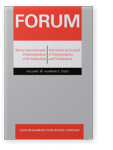Vol. 18:2 (2020) ► pp.127–149
A study of poetics in Coleman Barks’ translations of Rumi
Coleman Barks’ translations of Rumi’s works are astonishingly popular, especially among the American public. The study presented here deals particularly with the role of poetics in shaping the image and reception of Rumi’s works in the target language and culture. Thus, it describes and analyses Barks’ approach/strategies in rendering the poetic elements of Rumi’s poems, and examines Barks’ translation poetics in the context of the dominant poetics in the target literature. The corpus of the study is delimited to Barks’ renditions of the poems of the first book of the Masnavi included in The Essential Rumi (1995). The findings involve Barks’ modifications in favor of the formal and structural conventions of English poetry, the linguistic and literary norms of the target language and the taste and communicative needs of the target audience as well as the conformity of Barks’ translation poetics with the dominant poetics and ideology of his time.
Article outline
- 1.Introduction
- 2.Review of literature
- 3.Poetic elements: Barks’ translation approach/strategies
- 3.1Poetic form and structure
- 3.2Poetic diction
- 3.3Symbols
- 4.Barks’ translations: Dominant poetics
- 5.Conclusion
- Note
-
References
